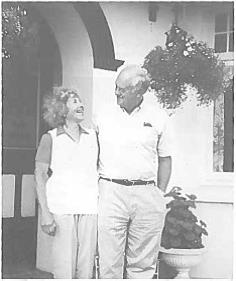Deceased March 11, 2017
View alumni profile (log in required)
Read obituary
50th Reunion Book Entry
In Memory
My father, Lloyd H. Conover, a proud member of the Illustrious Class of 1945, passed away at the age of 93 on March 11, 2017, in Saint Petersburg, Fla.
Lloyd entered Amherst as a freshman in 1941. Along with many of his classmates, he took time off from his studies to serve in the military during World War II, marrying Virginia Rogers Kirk (Wheaton College ’44) in New Orleans just before shipping out to the Pacific. Lloyd served as executive officer on an LST during the war, returning to Amherst and graduating in 1947.
Lloyd earned his doctorate in Chemistry from the University of Rochester, and in 1950 he joined Charles Pfizer, Inc., then a small enterprise with roots in agricultural medicine that had begun mass-producing penicillin during the war. In 1952, Lloyd invented the broad-spectrum antibiotic tetracycline.
This discovery grew from a scientific hunch: working with a team that had determined the chemical structures of two Pfizer antibiotics, Aureomycin and Terramycin, Lloyd intuited that since the recently deduced chemical structures of these two antibiotics were identical but for one branch of each molecule—an extra chlorine atom in Aureomycin and an additional hydroxyl group in Terramycin—these anomalous branches might be superfluous. He reasoned that if one could remove them, the resulting compound might also be therapeutically active, perhaps more so than the parent drug. Undeterred by skepticism from his colleagues as to the likelihood of success, Lloyd and a lab assistant succeeded on the first try, using an untested technique. I remember Dad coming home with a calm smile that night, and happily pronouncing one word: “Eureka!”
Testing revealed that the drug was more strongly therapeutic with fewer side effects than both Terramycin and Aureomycin. Tetracycline became for a time the world’s leading antibiotic, saving many lives. The first drug made by chemically altering an existing antibiotic—which until then were created by growing molds—Lloyd’s discovery opened the door to the vast potential in man-made antibiotics. A 1992 inductee of the National Inventors Hall of Fame, he has approximately 300 patents in his name.
Lloyd served as research director at Pfizer Central Research in Sandwich, England. A former colleague from Sandwich writing me of Dad’s arrival there is typical of many notes: “Lloyd had been sent … to fix the problems in Pfizer Central Research. He was recognized within and outside Pfizer as an outstanding research scientist and an excellent hands-on manager and his mission was to ‘whip Sandwich into shape.’ You can imagine the trepidation with which all of us awaited the arrival of the terrifying American axe man. What a surprise to meet a humane, sympathetic, friendly, thoughtful, open-minded scientist who recognized the shortcomings of the organization and also the worries and needs of those of us who worked there.”
Lloyd retired from Pfizer in 1984 as senior vice president of Agricultural Research.
Dad gave generously of himself to his friends, family and community. Among his many involvements, he was head of the local Cub Scout pack, chairman of the town Planning and Zoning Commission, and a guest chemistry lecturer at my daughters’ grade school. Dad established the Virginia Rogers Kirk Conover Conservancy in honor of our mother in Waterford, Conn., creating a place of peace and tranquility for generations to come.
Dad was young at heart. I saw him bend down to a child’s level to listen to a secret many times. He maintained a childlike wonder in the world all of his life, whether he was marveling at the latest scientific invention or listening to one of his grandchild’s compositions. I am immensely proud of him.
Lloyd’s first wife and my mother, the former Virginia Kirk, died in 1988, and his second wife, the former Marie Solomons, died in 2003. Besides Kirk, survivors include the former Katharine Meacham whom he married in 2005; two other sons, Craig and Roger; a daughter, Heather Conover; four stepdaughters, Sue Love, Virginia Karpovich, Katharine Meacham and Laura Keane; two stepsons, Walter Solomons and Andrew Meacham; 16 grandchildren; and eight great-grandchildren.
Kirk Conover ’82
